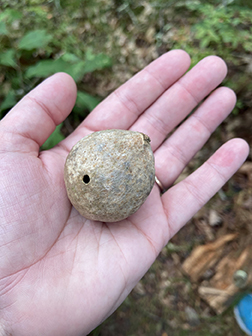By Catherine Hall
 Have you ever been exploring in your backyard, or perhaps along an SMF trail, and seen curious little orbs on the ground or hanging from an oak tree branch? From afar they may look like small apples—but they are actually a nursery of sorts for a tiny stingless wasp, Amphibolips confluenta, known as the oak apple gall wasp.
Have you ever been exploring in your backyard, or perhaps along an SMF trail, and seen curious little orbs on the ground or hanging from an oak tree branch? From afar they may look like small apples—but they are actually a nursery of sorts for a tiny stingless wasp, Amphibolips confluenta, known as the oak apple gall wasp.
Rather than working to construct a nest of her own, in the springtime, a female gall wasp will gently inject her eggs into the wood of an oak tree’s limbs. The oak tree then deploys a defense mechanism which causes the area to swell and form what are called galls. These galls provide the larvae with protection and nutrients as they develop inside the structure.
The gall begins as green and spongy in the spring during the larval and pupal stages. It will turn brown and papery after the adult wasp burrows a hole to emerge in summer, and drops from the tree in fall or winter. The galls are considered safe to handle once they are brown and have a hole (or several) signifying that the wasps have vacated the structure. Aside from being tiny marvels of nature, oak galls have also played a significant role in history.
Oak galls have been used to make ink since Ancient Roman times. According to an article in The Huntington, “Many medieval scribes walked around with a kit that included a pen knife, several quills, and an inkhorn full of gall ink.” Ink from galls was also popular during Colonial times. An article in revolutionarywarjournal.com explains how ink derived from galls was used by soldiers during the Revolutionary War: “Many used powdered ink – iron gall ink to be specific, which was made liquid and ready for use by just adding rain water, beer, or white wine.”





